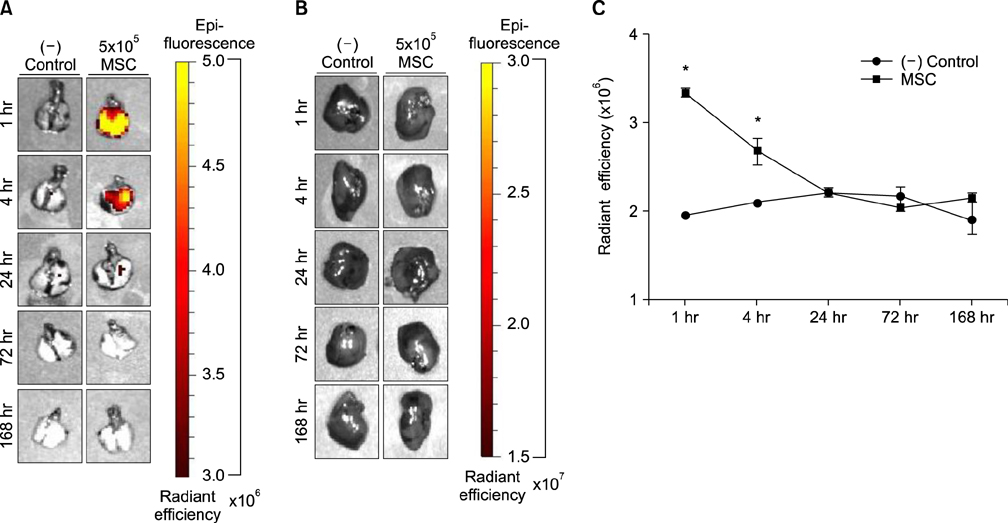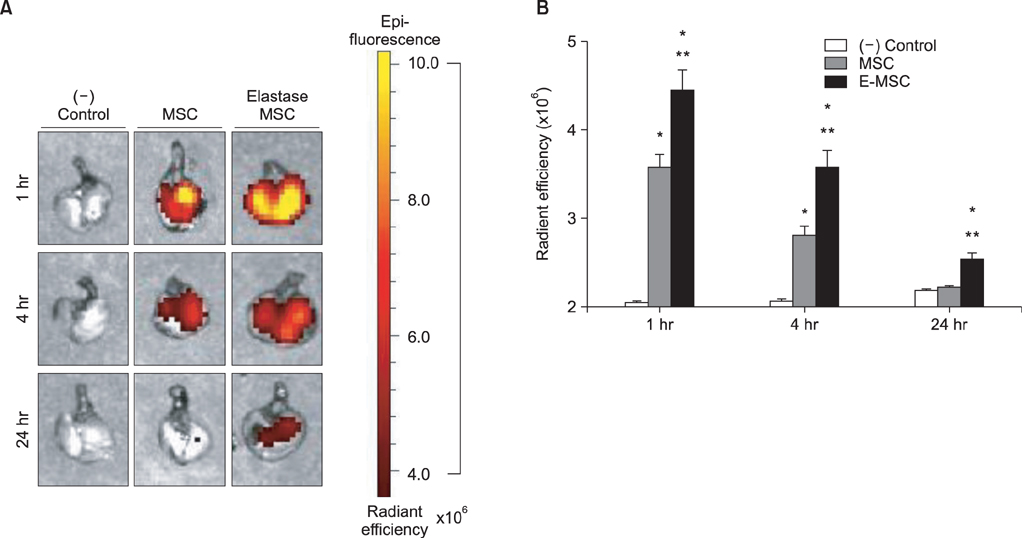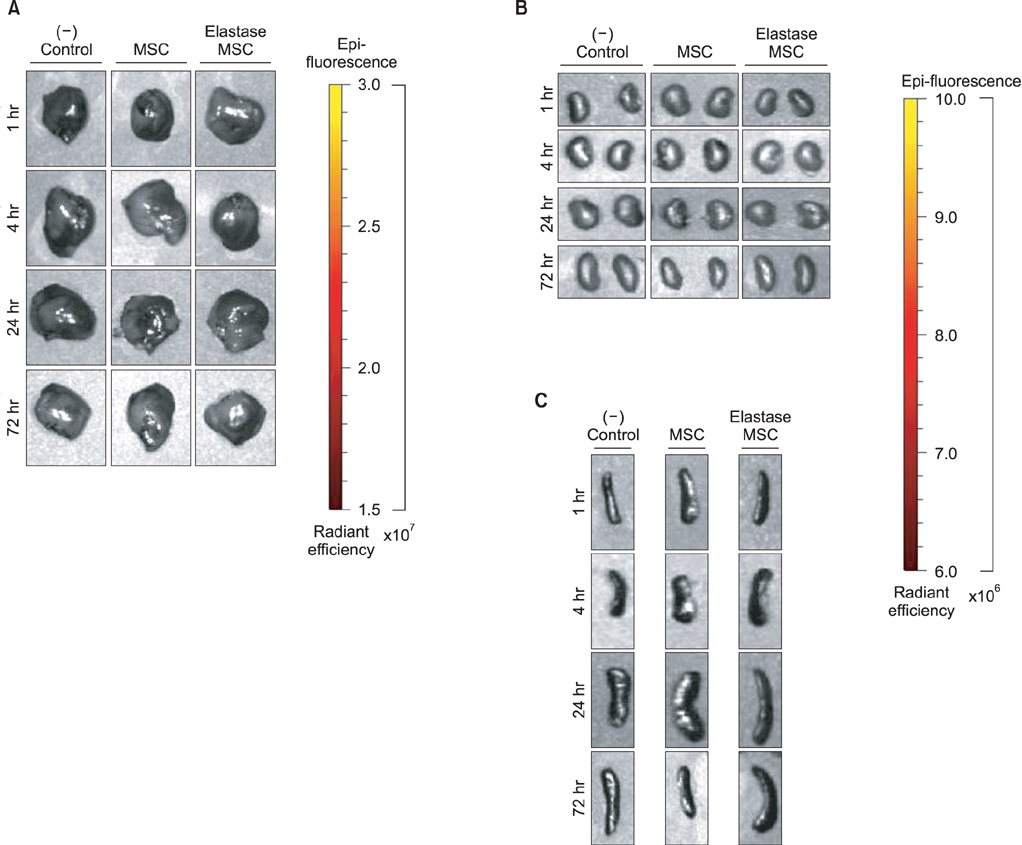Tuberc Respir Dis.
2014 Sep;77(3):116-123. 10.4046/trd.2014.77.3.116.
Tracking Intravenous Adipose-Derived Mesenchymal Stem Cells in a Model of Elastase-Induced Emphysema
- Affiliations
-
- 1Asan Institute for Life Science, Seoul, Korea. ymoh55@amc.seoul.kr
- 2University of Ulsan College of Medicine, Seoul, Korea.
- 3Department of Biomedical Sciences, Asan Medical Center, University of Ulsan College of Medicine, Seoul, Korea.
- 4Department of Pulmonary and Critical Care Medicine, Asthma Center, Clinical Research Center for Chronic Obstructive Airway Diseases, Asan Medical Center, Seoul, Korea.
- KMID: 2320557
- DOI: http://doi.org/10.4046/trd.2014.77.3.116
Abstract
- BACKGROUND
Mesenchymal stem cells (MSCs) obtained from bone marrow or adipose tissue can successfully repair emphysematous animal lungs, which is a characteristic of chronic obstructive pulmonary disease. Here, we describe the cellular distribution of MSCs that were intravenously injected into mice with elastase-induced emphysema. The distributions were also compared to the distributions in control mice without emphysema.
METHODS
We used fluorescence optical imaging with quantum dots (QDs) to track intravenously injected MSCs. In addition, we used a human Alu sequence-based real-time polymerase chain reaction method to assess the lungs, liver, kidney, and spleen in mice with elastase-induced emphysema and control mice at 1, 4, 24, 72, and 168 hours after MSCs injection.
RESULTS
The injected MSCs were detected with QD fluorescence at 1- and 4-hour postinjection, and the human Alu sequence was detected at 1-, 4- and 24-hour postinjection in control mice (lungs only). Injected MSCs remained more in mice with elastase-induced emphysema at 1, 4, and 24 hours after MSCs injection than the control lungs without emphysema.
CONCLUSION
In conclusion, our results show that injected MSCs were observed at 1 and 4 hours post injection and more MSCs remain in lungs with emphysema.
MeSH Terms
Figure
Cited by 1 articles
-
Potential Therapeutic Strategy in Chronic Obstructive Pulmonary Disease Using Pioglitazone-Augmented Wharton's Jelly-Derived Mesenchymal Stem Cells
Jin-Soo Park, Hyun Kuk Kim, Eun-Young Kang, RyeonJin Cho, Yeon-Mok Oh
Tuberc Respir Dis. 2019;82(2):158-165. doi: 10.4046/trd.2018.0044.
Reference
-
1. Kocher AA, Schuster MD, Szabolcs MJ, Takuma S, Burkhoff D, Wang J, et al. Neovascularization of ischemic myocardium by human bone-marrow-derived angioblasts prevents cardiomyocyte apoptosis, reduces remodeling and improves cardiac function. Nat Med. 2001; 7:430–436.2. Orlic D, Kajstura J, Chimenti S, Limana F, Jakoniuk I, Quaini F, et al. Mobilized bone marrow cells repair the infarcted heart, improving function and survival. Proc Natl Acad Sci U S A. 2001; 98:10344–10349.3. Horwitz EM, Prockop DJ, Fitzpatrick LA, Koo WW, Gordon PL, Neel M, et al. Transplantability and therapeutic effects of bone marrow-derived mesenchymal cells in children with osteogenesis imperfecta. Nat Med. 1999; 5:309–313.4. Khakoo AY, Pati S, Anderson SA, Reid W, Elshal MF, Rovira II, et al. Human mesenchymal stem cells exert potent antitumorigenic effects in a model of Kaposi's sarcoma. J Exp Med. 2006; 203:1235–1247.5. Koc ON, Gerson SL, Cooper BW, Dyhouse SM, Haynesworth SE, Caplan AI, et al. Rapid hematopoietic recovery after coinfusion of autologous-blood stem cells and culture-expanded marrow mesenchymal stem cells in advanced breast cancer patients receiving high-dose chemotherapy. J Clin Oncol. 2000; 18:307–316.6. Zhao DC, Lei JX, Chen R, Yu WH, Zhang XM, Li SN, et al. Bone marrow-derived mesenchymal stem cells protect against experimental liver fibrosis in rats. World J Gastroenterol. 2005; 11:3431–3440.7. Matthay MA, Goolaerts A, Howard JP, Lee JW. Mesenchymal stem cells for acute lung injury: preclinical evidence. Crit Care Med. 2010; 38:10 Suppl. S569–S573.8. Bonfield TL, Caplan AI. Adult mesenchymal stem cells: an innovative therapeutic for lung diseases. Discov Med. 2010; 9:337–345.9. Huh JW, Kim SY, Lee JH, Lee JS, Van Ta Q, Kim M, et al. Bone marrow cells repair cigarette smoke-induced emphysema in rats. Am J Physiol Lung Cell Mol Physiol. 2011; 301:L255–L266.10. Longhini-Dos-Santos N, Barbosa-de-Oliveira VA, Kozma RH, Faria CA, Stessuk T, Frei F, et al. Cell therapy with bone marrow mononuclear cells in elastase-induced pulmonary emphysema. Stem Cell Rev. 2013; 9:210–218.11. Cruz FF, Antunes MA, Abreu SC, Fujisaki LC, Silva JD, Xisto DG, et al. Protective effects of bone marrow mononuclear cell therapy on lung and heart in an elastase-induced emphysema model. Respir Physiol Neurobiol. 2012; 182:26–36.12. Shigemura N, Okumura M, Mizuno S, Imanishi Y, Nakamura T, Sawa Y. Autologous transplantation of adipose tissue-derived stromal cells ameliorates pulmonary emphysema. Am J Transplant. 2006; 6:2592–2600.13. Katsha AM, Ohkouchi S, Xin H, Kanehira M, Sun R, Nukiwa T, et al. Paracrine factors of multipotent stromal cells ameliorate lung injury in an elastase-induced emphysema model. Mol Ther. 2011; 19:196–203.14. Schweitzer KS, Johnstone BH, Garrison J, Rush NI, Cooper S, Traktuev DO, et al. Adipose stem cell treatment in mice attenuates lung and systemic injury induced by cigarette smoking. Am J Respir Crit Care Med. 2011; 183:215–225.15. Gupta N, Su X, Popov B, Lee JW, Serikov V, Matthay MA. Intrapulmonary delivery of bone marrow-derived mesenchymal stem cells improves survival and attenuates endotoxin-induced acute lung injury in mice. J Immunol. 2007; 179:1855–1863.16. Aslam M, Baveja R, Liang OD, Fernandez-Gonzalez A, Lee C, Mitsialis SA, et al. Bone marrow stromal cells attenuate lung injury in a murine model of neonatal chronic lung disease. Am J Respir Crit Care Med. 2009; 180:1122–1130.17. Yukawa H, Kagami Y, Watanabe M, Oishi K, Miyamoto Y, Okamoto Y, et al. Quantum dots labeling using octa-arginine peptides for imaging of adipose tissue-derived stem cells. Biomaterials. 2010; 31:4094–4103.18. Yukawa H, Watanabe M, Kaji N, Okamoto Y, Tokeshi M, Miyamoto Y, et al. Monitoring transplanted adipose tissue-derived stem cells combined with heparin in the liver by fluorescence imaging using quantum dots. Biomaterials. 2012; 33:2177–2186.19. Mighell AJ, Markham AF, Robinson PA. Alu sequences. FEBS Lett. 1997; 417:1–5.20. Schmid CW. Alu: structure, origin, evolution, significance and function of one-tenth of human DNA. Prog Nucleic Acid Res Mol Biol. 1996; 53:283–319.21. Nicklas JA, Buel E. Development of an Alu-based, real-time PCR method for quantitation of human DNA in forensic samples. J Forensic Sci. 2003; 48:936–944.22. Nicklas JA, Buel E. Development of an Alu-based, QSY 7-labeled primer PCR method for quantitation of human DNA in forensic samples. J Forensic Sci. 2003; 48:282–291.23. Kim SY, Lee JH, Kim HJ, Park MK, Huh JW, Ro JY, et al. Mesenchymal stem cell-conditioned media recovers lung fibroblasts from cigarette smoke-induced damage. Am J Physiol Lung Cell Mol Physiol. 2012; 302:L891–L908.24. Kraitchman DL, Tatsumi M, Gilson WD, Ishimori T, Kedziorek D, Walczak P, et al. Dynamic imaging of allogeneic mesen-chymal stem cells trafficking to myocardial infarction. Circulation. 2005; 112:1451–1461.25. Li Q, Zhou X, Shi Y, Li J, Zheng L, Cui L, et al. In vivo tracking and comparison of the therapeutic effects of MSCs and HSCs for liver injury. PLoS One. 2013; 8:e62363.26. Lin S, Xie X, Patel MR, Yang YH, Li Z, Cao F, et al. Quantum dot imaging for embryonic stem cells. BMC Biotechnol. 2007; 7:67.27. Garrovo C, Bergamin N, Bates D, Cesselli D, Beltrami AP, Lorenzon A, et al. In vivo tracking of murine adipose tissue-derived multipotent adult stem cells and ex vivo cross-validation. Int J Mol Imaging. 2013; 2013:426961.28. Harting MT, Jimenez F, Xue H, Fischer UM, Baumgartner J, Dash PK, et al. Intravenous mesenchymal stem cell therapy for traumatic brain injury. J Neurosurg. 2009; 110:1189–1197.29. Son BR, Marquez-Curtis LA, Kucia M, Wysoczynski M, Turner AR, Ratajczak J, et al. Migration of bone marrow and cord blood mesenchymal stem cells in vitro is regulated by stromal-derived factor-1-CXCR4 and hepatocyte growth factor-c-met axes and involves matrix metalloproteinases. Stem Cells. 2006; 24:1254–1264.30. Chen T, Bai H, Shao Y, Arzigian M, Janzen V, Attar E, et al. Stromal cell-derived factor-1/CXCR4 signaling modifies the capillary-like organization of human embryonic stem cell-derived endothelium in vitro. Stem Cells. 2007; 25:392–401.31. Zhang Y, Wittner M, Bouamar H, Jarrier P, Vainchenker W, Louache F. Identification of CXCR4 as a new nitric oxide-regulated gene in human CD34+ cells. Stem Cells. 2007; 25:211–219.32. Werner L, Guzner-Gur H, Dotan I. Involvement of CXCR4/CXCR7/CXCL12 Interactions in Inflammatory bowel disease. Theranostics. 2013; 3:40–46.33. Theiss HD, Vallaster M, Rischpler C, Krieg L, Zaruba MM, Brunner S, et al. Dual stem cell therapy after myocardial infarction acts specifically by enhanced homing via the SDF-1/CXCR4 axis. Stem Cell Res. 2011; 7:244–255.34. Murphy MB, Moncivais K, Caplan AI. Mesenchymal stem cells: environmentally responsive therapeutics for regenerative medicine. Exp Mol Med. 2013; 45:e54.
- Full Text Links
- Actions
-
Cited
- CITED
-
- Close
- Share
- Similar articles
-
- Therapeutic effects of adipose-derived stem cells pretreated with pioglitazone in an emphysema mouse model
- Potential Therapeutic Strategy in Chronic Obstructive Pulmonary Disease Using Pioglitazone-Augmented Wharton's Jelly-Derived Mesenchymal Stem Cells
- The Therapeutic Effects of Optimal Dose of Mesenchymal Stem Cells in a Murine Model of an Elastase Induced-Emphysema
- L-Theanine-Treated Adipose-Derived Mesenchymal Stem Cells Alleviate the Cytotoxicity Induced by N-Nitrosodiethylamine in Liver
- Concise Review: Differentiation of Human Adult Stem Cells Into Hepatocyte-like Cells In vitro






